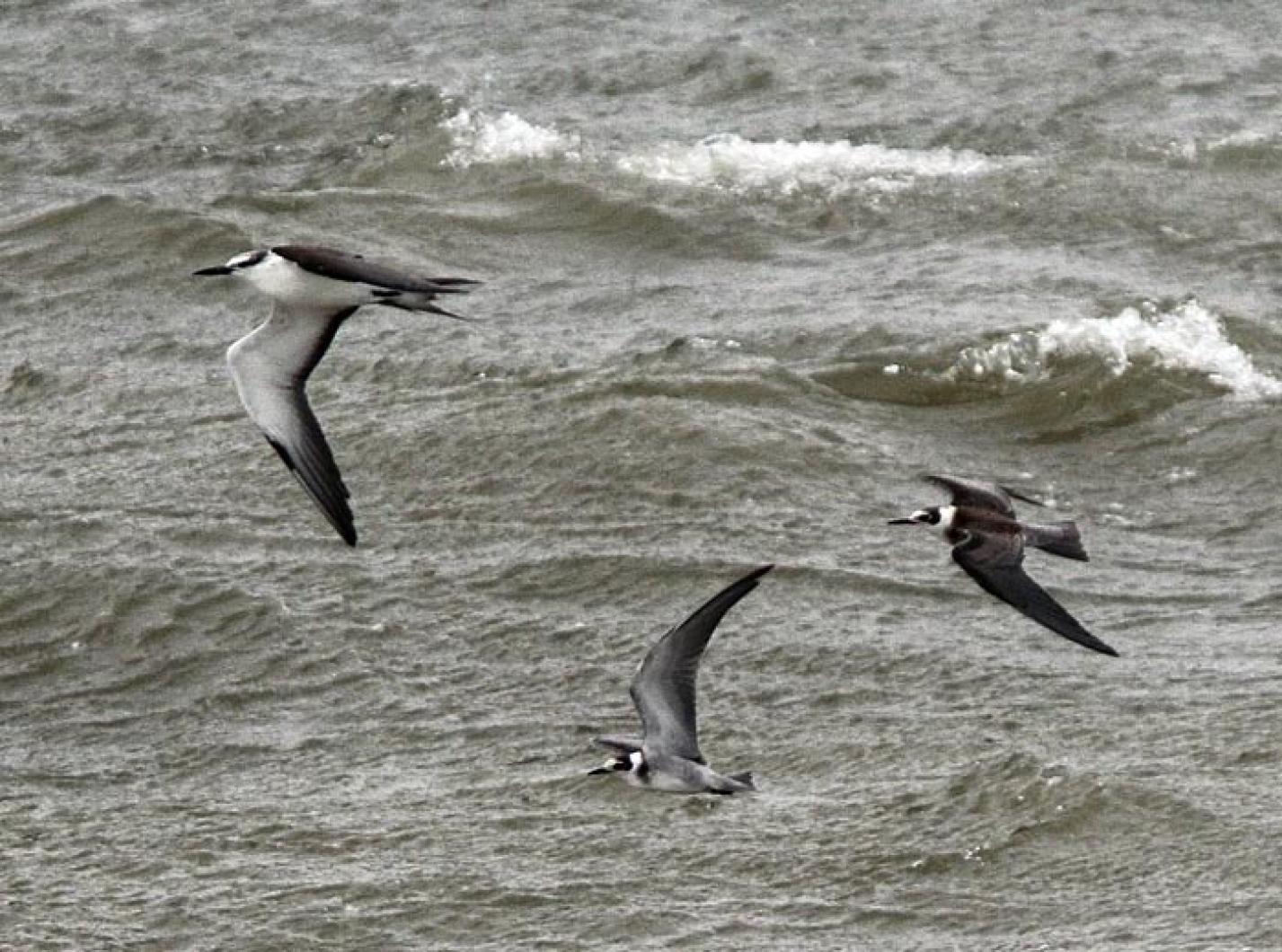The Vineyard birders predicted storm driven birds to land on our shores. Our wish came true. Hurricane Irene brought the Vineyard a group of unusual birds, two vagrants and a few that we expect sooner or later in the fall.
The two most interesting arrivals were bridled and sooty terns. A single bridled was seen and photographed in the afternoon at Lobsterville on August 28. Two sooty terns were seen and photographed around 6 p.m. at Katama the same day. The word got out on the bridled tern and most of the Vineyard birders made their way up to Lobsterville to get a glimpse of the bridled tern. Unfortunately for the birders, only one person saw and photographed the sooty terns, but thankfully for the sooty terns, they were gone the next morning.
It turns out Lobsterville was the place to be! There were nine species of terns seen in and around West Basin and the outer beach of Lobsterville. The bridled tern was on the outer beach at Lobsterville. There were a couple of big royal terns, several petite black terns, a Sandwich tern, several Forster’s terns, roseate, common and least terns all sitting on the shore or the railings of the boats in the basin.
Bridled and sooty terns are rare vagrants on the Island and are only seen after hurricanes or tropical storms. The last reports of these two species were 10 years ago after Hurricane Bob on August 19, 1991 and both were seen at Lobsterville! Sandwich terns are considered an uncommon vagrant but with more birders familiar with this southern species, we can expect a few to be seen between June and September. Royal terns formerly were seen only after hurricanes or tropical storms. Now we see them fairly regularly between July and October. The arrival of Forster’s and black terns is an almost annual fall event although black terns are less likely to occur annually. Both these terns breed in the north central and western parts of our country and wander to or are blown towards our coast in the fall.
Common, roseate and least terns are summer residents and breeders depending on the year. Most of the least terns had migrated south prior to Irene, so they had an abrupt rerouting thanks to the weather. There probably were a few common and roseate terns that were rerouted by Irene as well. The birding after a hurricane is always a treat and this year one good tern deserved another.
Bird Sightings
The sequence of sightings for Irene is as follows: August 28 Flip Harrington and I spotted two royal terns and one black tern before 8 a.m. in Tisbury Great Pond. Around noon two Forster’s terns joined the other two tern species and least terns arrived around 6 p.m. Allan Keith found a bridled tern at Lobsterville along with black, common, roseate and Foster’s terns. Matt Pelikan found two black terns at Sarson’s Island and counted 16 black terns, 40 roseate, 60 common and 200 least terns at Eel Pond. Matt spotted a Wilson’s storm petrel in Katama Bay and an American golden plover in the fields. Luanne Johnson and Liz Baldwin birded Edgartown Great Pond and their best bird was a Hudsonian godwit. They also spotted black and royal terns and red knots. Pete Gilmore and Lanny McDowell found an upland plover at Katama and Flip Harrington and I found a red knot in the same field. Flip, Lanny, Pete and I heard about the bridled tern Allan found and traveled up to Lobsterville where Lanny photographed the bridled and black terns and we all saw the eight species of terns that Irene sent us! At 6 p.m. Mary Jane Makepeace was driving down Herring Creek Road and spotted two bedraggled birds in the parking lot. They were two sooty terns! She photographed them so we have a great record of her sighting.
On August 29 Flip Harrington, Allan Keith, Pete Gilmore and I went back to Lobsterville and checked Quansoo and Black Point. We had common, least and Forster’s terns at Quansoo. Lobsterville produced royal, Sandwich, roseate, common, Forster’s and black terns. Luanne Johnson had royal, Forster’s and common terns at Katama. Matt Pelikan spotted two black and three Foster’s terns and a stilt sandpiper at Norton Point.
Warren Woessner found two upland sandpipers and an American golden plover at the Farm Institute and a royal tern at Eel Pond.
Many shorebirds were seen on the above dates by all and included the regulars which are semipalmated, piping and black-bellied plovers, greater and lesser yellowlegs, least, semipalmated, spotted and white-rumped sandpipers, ruddy turnstones, sanderlings and short-billed dowitchers.
Tom Rivers reported that during Irene he and Barbara watched a pair of American robins protecting three fledglings in a nest next to their house. The Rivers heard both whippoorwills and screech owls on August 25 and a yellow-billed cuckoo on the August 27.
Elaine Frost called with great news. She counted four bobwhites on her porch in Blacksmith Valley, Chilmark on August 27.
Dick Jennings found a dead Sandwich tern at Wasque on August 30. The bird was banded and we should hear in a week where it was banded. Stay tuned.
The terns blown in by Irene may remain for a few days, so grab your binoculars and find an interesting bird visitor.
Please report your bird sightings to the Martha’s Vineyard Bird Hotline at 508-645-2913 or e-mail to birds@mvgazette.com.
Susan B. Whiting is the coauthor of Vineyard Birds and Vineyard Birds II. Her Web site is vineyardbirds2.com.




Comments
Comment policy »